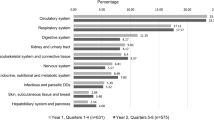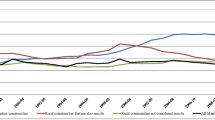Abstract
Background
To compare health status and health services use of Registered First Nations to all other Manitobans (AOM). If the Canadian health care system is meeting underlying need, those experiencing the greatest burden of morbidity and mortality should show the highest rates of health service use.
Methods
Registered First Nations’ (n=85,959) hospitalization and physician visit rates were compared to rates of all other Manitobans (n=1,054,422) for fiscal year 1998/99. The underlying “need” for health care was measured using premature mortality (PMR), an age-and sex-adjusted rate of death before age 75. Data were derived from Manitoba’s Population Health Research Data Repository, linked to federal Status Verification System files to determine Registered First Nations status.
Results
Registered First Nations’ PMR was double the rate of all other Manitobans (6.61 vs. 3.30 deaths per thousand, p<0.05). Registered First Nations ambulatory physician visit rates (6.13 vs. 4.85 visits per person, p<0.05), hospital separation rates (0.348 vs. 0.156 separations per person, p<0.05) and total days of hospital care (1.75 vs. 1.05 days per person, p<0.05) were higher than AOM rates. Consultation rates (first visit to a specialist) were slightly higher for Registered First Nations (0.29 vs. 0.27 visits per person, p<0.05), and overall specialist visit rates were lower (0.895 vs. 1.284 visits per person, p<0.05) compared with AOM.
Conclusion
Although hospitalization and ambulatory physician visit rates for First Nations reflect their poorer health status, consult and specialist rates do not reflect the underlying need for health care services.
Résumé
Contexte
Cette étude visait à comparer l’état de santé des membres inscrits des Premières nations et leur utilisation des services de santé par rapport au reste de la population du Manitoba. Si le système de soins de santé canadien répond vraiment aux besoins sous-jacents, les personnes dont le fardeau de morbidité et de mortalité est le plus élevé devraient présenter les taux d’utilisation des services de santé les plus élevés.
Méthode
Nous avons comparé les taux d’hospitalisation et de visites chez le médecin des membres inscrits des Premières nations (n = 85 959) aux taux comparables dans le reste de la population du Manitoba (n = 1 054 422) pour l’exercice 1998–1999. Pour mesurer le „ besoin ” sous-jacent en services de santé, nous avons utilisé le taux de mortalité prématurée (TMP) - un taux de décès avant 75 ans ajusté selon l’âge et le sexe. Les données ont été dérivées du registre Population Health Research Data Repository du Manitoba, une base de données liée au Système de vérification du statut fédéral, pour déterminer le statut de membre inscrit des Premières nations.
Résultats
Le TMP des membres inscrits des Premières nations était le double du taux dans le reste de la population du Manitoba (6,61 c. 3,30 décès p. 1 000, p<0,05). Le nombre de visites dans les cliniques de soins ambulatoires effectuées par les membres inscrits des Premières nations (6,13 c. 4,85 visites par personne, p<0,05), les taux de diagnostic-congé (0,348 c. 0,156 congé par personne, p<0,05) et le nombre total de journées de soins hospitaliers (1,75 c. 1,05 jour par personne, p<0,05) étaient plus élevés que dans le reste de la population du Manitoba. Les taux de consultation (première visite chez un spécialiste) étaient légèrement supérieurs chez les membres inscrits des Premières nations (0,29 c. 0,27 visite par personne, p<0,05), et les taux globaux de visites chez les spécialistes étaient inférieurs (0,895 c. 1,284 visite par personne, p<0,05) aux taux dans le reste de la population du Manitoba.
Conclusion
Les taux d’hospitalisation et de visites dans les cliniques de soins ambulatoires relevés chez les membres des Premières nations sont conformes à leur moins bon état de santé, mais les taux de consultation et de visites chez les spécialistes ne correspondent pas aux besoins sous-jacents des Premières nations sur le plan des services de santé.
Similar content being viewed by others
References
Blandford AA, Chappell NL. Subjective well-being among Native and non-Native elderly persons: Do differences exist? Can J Aging 1990;9(4):386–99.
Carr VA, Lee ES. Navajo tribal mortality: A life table analysis of the leading causes of death. Soc Biol 1978;25:279–87.
Young TK. The Health of Native Americans: Toward a Biocultural Epidemiology. New York: Oxford University Press, 1994.
MacMillan HL, MacMillan AB, Offord DR, Dingle JL. Aboriginal health. CMAJ 1996;155(11):1569–78.
Northern Health Research Unit, Assembly of Manitoba Chiefs, Manitoba Keewatinowi Okimakanak. Manitoba First Nations Regional Health Survey. Final Report: September, 1998. Winnipeg: University of Manitoba, 1998.
Young TK, O’Neil JD, Elias B. Chapter 3: Chronic Diseases. In: First Nations and Inuit Regional Health Survey: National Report 1999. Ottawa: First Nations and Inuit Regional Health Survey National Steering Committee, 1999.
Health Canada. A Statistical Profile on the Health of First Nations in Canada. Ottawa: Health Canada, 2003.
Carstairs V, Morris R. Deprivation and Health in Scotland. Aberdeen, Scotland: Aberdeen University Press, 1991.
Eyles J, Birch S, Chambers S, Hurley J, Hutchinson B. A needs-based methodology for allocating health care resources in Ontario, Canada: Development and an application. Soc Sci Med 1991;33(4):489–500.
Eyles J, Birch S. A population needs-based approach to health care resource allocation and planning in Ontario: A link between policy goals and practice? Can J Public Health 1993;84(2):112–17.
Reid RJ, Roos NP, MacWilliam L, Frohlich N, Black C. Assessing population health care need using a claims-based ACG morbidity measure: A validation analysis in the province of Manitoba. Health Serv Res 2002;37(5):1345–64.
Martens PJ, Frohlich N, Carriere KC, Derksen S, Brownell M. Embedding child health within a framework of regional health: Population health status and sociodemographic indicators. Can J Public Health 2002;93(Suppl. 2):S15–S20.
Wigle DT. Canada’s health status: A public health perspective. Risk Anal 1995;15(6):693–98.
Jahrig K. Relevance of socio-economic data for the establishment of solution models based on international statistical material. Arztl Jugendkd 1990;81(1):14–22.
Dogramaci I. Parameters for child health. S Afr Med J 1981;60(2):49–56.
Hertz E, Hebert JR, Landon J. Social and environmental factors and life expectancy, infant mortality, and maternal mortality rates: Results of a cross-national comparison. Soc Sci Med 1994;39(1):105–14.
Adeyi O, Chellaraj G, Goldstein E, Preker A, Ringold D. Health status during the transition in Central and Eastern Europe: Development in reverse? Health Policy Plan 1997;12(2):132–45.
Pegels CC. A cross-sectional country group study of three health level outcomes and four potential causes. Int J Health Plann Manage 1989;4(2):107–16.
Martens PJ, Fransoo R, The Need To Know Team, Burland E, Jebamani L, Burchill C, et al. The Manitoba RHA Indicators Atlas: Population-based Comparisons of Health and Health Care Use. Winnipeg: Manitoba Centre for Health Policy, June 2003.
Martens PJ, Bond R, Jebamani LS, Burchill CA, Roos NP, Derksen SA, et al. The Health and Health Care Use of Registered First Nations People Living in Manitoba: A Population-Based Study. Winnipeg: Manitoba Centre for Health Policy, 2002.
Jebamani LS, Burchill CA, Martens PJ. Using data linkage to identify First Nations Manitobans: Technical, ethical, and political issues. Can J Public Health 2005;96(Suppl. 1):S28–S32.
Katz A, DeCoster C, Bogdanovic B, Soodeen RA, Chateau D. Using Administrative Data to Develop Indicators of Quality in Family Practice. Winnipeg: Manitoba Centre for Health Policy, 2004.
Roos NP, Fransoo R, Bogdanovic B, Friesen D, MacWilliam L. Issues in the Management of Specialist Physician Resources for Manitoba. Winnipeg: Manitoba Centre for Health Policy and Evaluation, 1997.
Carriere K, Roos LL. A method of comparison for standardized rates of low-incidence events. Med Care 1997;35(1):57–69.
Waldram JB, Herring DA, Young TK. Aboriginal Health in Canada: Historical, Cultural, and Epidemiological Perspectives. Toronto: University of Toronto Press, 1995.
Newbold KB. Aboriginal physician use in Canada: Location, orientation and identity. Health Econ 1997;6(2):197–207.
Author information
Authors and Affiliations
Corresponding author
Additional information
The full report “The Health and Health Care Use of Registered First Nations People Living in Manitoba: A Population-Based Study” on which this article is based is available from the Manitoba Centre for Health Policy at the above address or on-line at: https://doi.org/www.umanitoba.ca/centres/mchp/reports.htm
Acknowledgements of Sources of Support: This work was supported as part of a project on First Nations health in Manitoba, one of several projects undertaken each year by the Manitoba Centre for Health Policy under contract to Manitoba Health. The results and conclusions are those of the authors and no official endorsement by Manitoba Health was intended or should be inferred. Dr. Martens is also supported by a Community Alliances for Health Research Program grant from the Canadian Institutes of Health Research (CIHR), as well as a CIHR New Investigator’s Award. The authors are indebted to Health Information Services, Manitoba Health, First Nations and Inuit Health Branch, Indian and Northern Affairs Canada, and the Office of Vital Statistics in the Agency of Consumer and Corporate Affairs for the provision of data. Thanks to the Health Information Research Committee of the Assembly of Manitoba Chiefs, who acted as the Working Group (1999-2002) for the First Nations Report from which this paper was derived.
Rights and permissions
About this article
Cite this article
Martens, P.J., Sanderson, D. & Jebamani, L. Health Services Use of Manitoba First Nations People: Is It Related to Underlying Need?. Can J Public Health 96 (Suppl 1), S39–S44 (2005). https://doi.org/10.1007/BF03405315
Published:
Issue Date:
DOI: https://doi.org/10.1007/BF03405315




